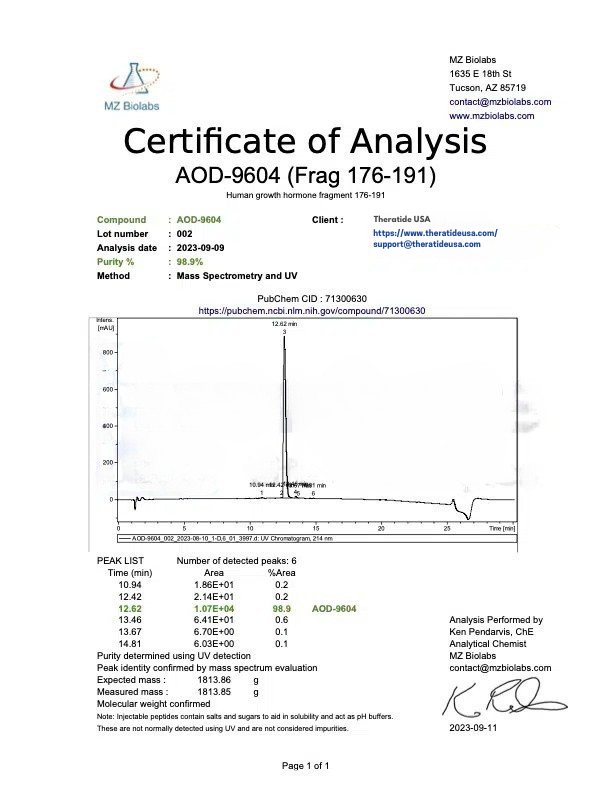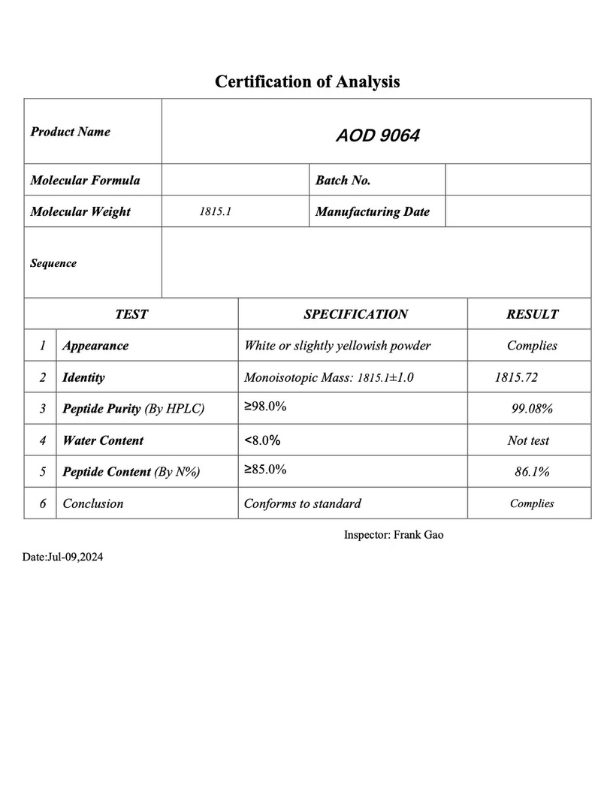Product Overview
What is AOD9604?
AOD9604 is a modified version of fragment 176-191, a smaller segment of human growth hormone (HGH), originally developed as an anti-obesity drug. It has lipolytic (fat-burning) properties while having minimal effects on IGF-1 or insulin levels, reducing risks of glucose intolerance or diabetes.
AOD9604 Peptide Structure

Sequence: Tyr-Leu-Arg-Ile-Val-Gln-Cys-Arg-Ser-Val-Glu-Gly-Ser-Cys-Gly-Phe (disulfide bridge Cys7-Cys15)
Molecular Formula: C78H123N23O23S2
Molecular Weight: 1815.12 g/mol
PubChem CID: 16131447
CAS Number: 386264-39-7
AOD9604 Research Highlights
- Obesity: Phase 2 trials showed it tripled weight loss compared to placebo in obese individuals.
- Joint Health: Demonstrated improvement in osteoarthritis and cartilage repair in animal models.
- Cardiovascular Benefits: May improve heart health beyond just reducing fat burden.
Referenced Citations
- F. M. Ng, J. Sun, L. Sharma, R. Libinaka, W. J. Jiang, and R. Gianello, “Metabolic studies of a synthetic lipolytic domain (AOD9604) of human growth hormone,” Horm. Res., vol. 53, no. 6, pp. 274–278, 2000.
- H. Stier, E. Vos, and D. Kenley, “Safety and Tolerability of the Hexadecapeptide AOD9604 in Humans,” J. Endocrinol. Metab., vol. 3, no. 1–2, pp. 7–15, Apr. 2013.
- “Obesity drug codenamed AOD9604 highly successful in trials,” News-Medical.net, 16-Dec-2004. [Online]. Available: [Accessed: 24-May-2019].
- R. Zieba, “Obesity: a review of currently used antiobesity drugs and new compounds in clinical development,” Postepy Hig. Med. Doswiadczalnej Online, vol. 61, pp. 612–626, Oct. 2007.
- M. Heffernan et al., “The Effects of Human GH and Its Lipolytic Fragment (AOD9604) on Lipid Metabolism Following Chronic Treatment in Obese Mice and β3-AR Knock-Out Mice,” Endocrinology, vol. 142, no. 12, pp. 5182–5189, Dec. 2001.
- D. R. Kwon and G. Y. Park, “Effect of Intra-articular Injection of AOD9604 with or without Hyaluronic Acid in Rabbit Osteoarthritis Model,” Ann. Clin. Lab. Sci., vol. 45, no. 4, pp. 426–432, Jul. 2015.
- M. D. Jensen, “Potential role of new therapies in modifying cardiovascular risk in overweight patients with metabolic risk factors,” Obes. Silver Spring Md, vol. 14 Suppl 3, pp. 143S–149S, Jun. 2006.
- H. Stier, E. Vos, D. Kenley, “Safety and Tolerability of the Hexadecapeptide AOD9604 in Humans,” Journal of Endocrinology and Metabolism, North America, 3, Apr. 2013.
ALL ARTICLES AND PRODUCT INFORMATION PROVIDED ON THIS WEBSITE ARE FOR INFORMATIONAL AND EDUCATIONAL PURPOSES ONLY.
The products offered on this website are furnished for in-vitro studies only. In-vitro studies (Latin: in glass) are performed outside of the body. These products are not medicines or drugs and have not been approved by the FDA to prevent, treat, or cure any medical condition, ailment or disease. Bodily introduction of any kind into humans or animals is strictly forbidden by law.
COA
Below are the Certificates of Analysis confirming the purity and quality of our AOD9604:



Storage Instructions
All of our products are manufactured using the Lyophilization (Freeze Drying) process, which ensures that our products remain 100% stable for shipping for up to 3–4 months.
Once the peptides are reconstituted (mixed with bacteriostatic water), they must be stored in the refrigerator to maintain stability. After reconstitution, the peptides will remain stable for up to 30 days.
Lyophilization is a unique dehydration process, also known as cryodesiccation, where the peptides are frozen and then subjected to low pressure. This causes the water in the peptide vial to sublimate directly from solid to gas, leaving behind a stable, crystalline white structure known as lyophilized peptide. The puffy white powder can be stored at room temperature until you're ready to reconstitute it with bacteriostatic water.
Once peptides have been received, it is imperative that they are kept cold and away from light. If the peptides will be used immediately, or in the next several days, weeks, or months, short-term refrigeration under 4°C (39°F) is generally acceptable. Lyophilized peptides are usually stable at room temperatures for several weeks or more, so if they will be utilized within weeks or months, such storage is typically adequate.
For longer-term storage (several months to years), it is preferable to store peptides in a freezer at -80°C (-112°F). When storing peptides for months or even years, freezing is optimal to preserve the peptide’s stability.
For further information on proper storage techniques, click the link below:









